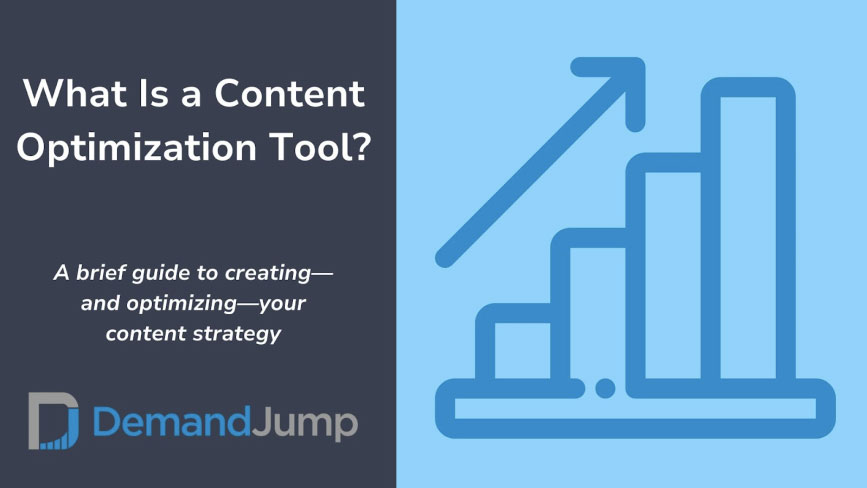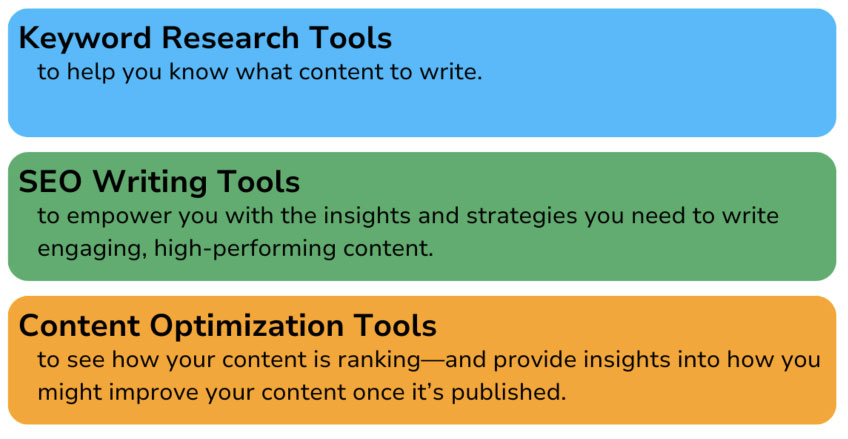What Is a Content Optimization Tool?
December 19, 2023 •Tamzin Walters

Way (way) back in 1996, Bill Gates famously declared that “content is king.” He didn’t stop there, though, as he commented on the seemingly endless (even then) amount of content on the internet and the importance of creating something that stands out. In fact, he went on to predict that “ there would eventually be an enormous breadth of information, and as such, it would take a high volume of content to stand out.”
Well, Bill Gates, you’re totally right—even in 2024.
This brings us to the modern notion of SEO writing and content optimization, which may have begun as a vague idea or mission but has since become more of a methodology—both an art and a science.
Especially if you’ve been writing blogs and other website content for your brand that’s not seeing the results you expect, you’ve landed on the right article today. We’re going to offer a quick primer of content optimization, namely:
- What SEO content optimization is, and why it’s important
- How to write SEO optimized content that improves your search rankings
- The best content optimization tools to use
What Is Content Optimization, and Why Is Content Optimization Important?
In the context of SEO, “content optimization” refers to producing highly-compelling content that will perform well with search engines. By extension, then, content optimization also includes things like publishing and interlinking strategies, matching content to searcher/buyer intent, fine-tuning content to overtake the competition, and so on.
For most organizations, two things are often true—at the same time:
- Producing content is not particularly difficult.
- Producing content that performs well—meaning it connects with customers, builds authority, and drives results—can be quite difficult.
And so, for modern organizations that are looking to make their mark, the importance of content optimization in SEO writing is difficult to overstate. In other words, in 2024, we’re suggesting that while content remains important, content optimization is the new king.
What Is the Best Way to Optimize a Content Strategy?
The best way to optimize a content strategy is to produce the right content, at the right time, and for the right audience. As we’ve already noted, content optimization is both an art and a science:
- The art is in writing content that is engaging and easy to understand.
- The science is in choosing the right topics, keywords, and even interlinking strategies.
Getting the art and science both right, and in harmony with each other, doesn’t happen by accident. You’ll need to rely on more than just a gut instinct—you’ll need things like keyword research, historical insights, and analysis of your competitors, as well.
What Are Optimization Tools, and How Do They Improve SEO?
SEO optimization tools exist to make marketers’ jobs easier—and to empower them with the insights they need to succeed with their content strategies. For better or worse, there are countless tools available to help with virtually every aspect of content creation and optimization, like keyword research, SEO writing, and content optimization.

When combined, these content optimization tools and techniques can streamline your writing process and help you know exactly how well your content is performing (and how to improve it).
The sheer number of optimization tools available to the modern content marketer is like a double-edged sword. Sure, it’s great to have options, but it can be difficult to find the best optimization tools and techniques to use—and how to get them to work well together.
That’s where DemandJump enters the scene. Our platform is more than “just another content optimization tool”—it’s more like an SEO toolbox than an individual tool. Within a single, intuitive platform, you can perform keyword research, use SEO writing tools to effectively create and optimize content, and monitor how well your content performs over time.
What Is an Example of Content Optimization?
A typical, end-to-end content optimization process consists of three key phases:
- Knowing what to write about (what your audience wants)
- Writing compelling content that engages readers and builds authority
- Optimizing existing content to improve results over time
Let’s say you’ve just been hired to be a content strategist or writer for a software company and you need to spin up some content for the company’s website. Your goal is to engage potential customers who are looking for the type of solution you offer. How are you going to get their attention, educate and inspire them, and ultimately get them to sign up for a product demo?
Knowing what to write about starts with—or should start with—data. It’s a much more sound strategy than crossing your fingers and hoping for the best. With that in mind, let’s jump into the first phase of content optimization—knowing what to write about.

Knowing What to Write About
If your goal is to capture potential buyers’ attention when they’re searching for a product or service like yours, you’ll need two key things:
- An understanding of search engine optimization (SEO) best practices
- Real-time insights into what your customers are searching for right now
DemandJump makes keyword research easy. With just a few clicks, you can easily see what keywords and questions are being searched. From there, you can create a network of potential content ideas that will align with buyer intent and search behavior, building a foundation of relevant, high-quality content for your optimization strategy.

Writing Compelling Content
Once you’ve decided on the topics that will have the most impact with your ideal audience, you’re ready to write. As we mentioned earlier, content optimization in digital marketing is both an art and a science: Phase 1 is largely the science, whereas this phase is the art. You’ll need to write content that is informative and accurate, but also engaging and unique.
As you write and prepare to publish your content, there are certain strategies you can use to improve your odds of success. For example, Pillar-Based Marketing (PBM) is an innovative approach that combines keyword research with data-backed strategies for organizing and interlinking your content to create a “web” or “network” of content that readers and search engines will see the value in.
With DemandJump, the first—and only—PBM platform on the market, you won’t have to rely on guesswork. A typical PBM strategy involves publishing 16 inter-related pieces of content:
- 1x 3,000-word Pillar Page that offers a comprehensive overview of a topic.
- 3x 2,000-word Sub-Pillars that explore more specific aspects of the Pillar topic.
- 12x 750-word Supporting Blogs, each of which addresses a specific topic of question.
Let’s say your ideal audience is an IT professional who might be looking for tools that can make their life a little easier. If you’re following the PBM methodology, you might write:
- 1x 3,000-word Pillar page about “IT Tools”
- 3x 2,000-word Sub-Pillars each focus on a unique subset of IT tools (e.g., “Cybersecurity Tools for IT”)
- 12x 750-word Supporting Blogs, addressing specific questions related to IT tools (e.g., “What are the best cybersecurity tools for a small business?”)
Now, imaging your ideal customer, the IT professional looking to upgrade their toolset. You can imagine them Googling the “cybersecurity tools” question, and finding your blog. They read it, find it interesting, and want to learn more. So they read the related Sub-Pillar and Pillar next, each of which provides them with more information—and a gentle nudge to explore your company’s solution or solutions in more detail. Ultimately, they sign up for a demo, love what they see, and become a qualified lead—or a new customer.

Optimizing Existing Content
An effective content strategy is not a “set it and forget it” kind of thing; instead, it’s an ongoing process that can, and should, be maintained over time. This is where we get into the real nitty-gritty of content optimization.
Once your content is published, it’s important to track how it performs over time. Not just that, you’ll also want to know which pieces of content are performing best, and why. This can pose a substantial challenge for content marketers without the right toolset. With DemandJump, it’s easy to track your keywords, questions, and content—not just how they’re performing, but how they’re impacting your positioning against your competitors, as well.
By providing insights into search volume and rankings over time, DemandJump streamlines this revision process. You can swap under-performing keywords with trending new ones, fine-tune the audience alignment, and so on. And as the competitive landscape changes, you can take an agile and dynamic approach to content optimization, improving your results over time.
How Can I Get Started with Content Optimization?
Much like the idea of “measuring twice, cutting once,” content optimization works best when you start with the right data. After all, SEO keyword research is the foundation of virtually any effective content strategy.
DemandJump’s platform offers a unique SEO content writing and optimization experience, bringing all three phases of content optimization into a single, unified platform. With DemandJump, you can:
- Perform keyword research, to know exactly who your audience is, and what they care about.
- Write compelling content, and publish it in a way that will improve your search rankings and competitive positioning.
- Monitor and improve content over time, to maintain your authority and prevent your results from dropping off when a new competitor enters the scene or Google tweaks its algorithm.
Content Optimization Doesn’t Have to Be Hard…
…and with DemandJump, it isn’t! Visit our website to learn more about how our platform can help you with all three phases of content optimization. From detailed, real-time keyword research and competitive insights to organizational tools and performance monitoring, you can find it all in a single platform—but only with DemandJump.
Are You Ready to Harness the Art and Science of Content Optimization with DemandJump?
Use the buttons below to take a free tour of the platform, or to start using it (for free) today. If you still have questions, or would like to chat about the content optimization checker tool we’ll soon be introducing as a beta feature, contact us today
Featured Articles
Categories
- Attribution Tracking (13)
- Channel Optimization (11)
- Consumer Insights (68)
- Content Marketing (251)
- Data Science (8)
- Digital Marketing (6)
- Digital Transformation (26)
- Enterprise (10)
- Lead Generation (14)
- Market Intelligence (8)
- Marketing Analytics (39)
- Marketing Attribution (57)
- Marketing Management (153)
- Marketing Operations (86)
- Organic Search (222)
- Paid Search (52)
- Pillar-Based Marketing (63)
- Programmatic Advertising (9)
- SaaS Content (14)
- SaaS Marketing (29)
- Search Marketing (111)
- SEO Keyword Research (28)
- SEO Pillar (18)
- SEO Strategy (46)
- SMB (5)
- Website Content (12)

